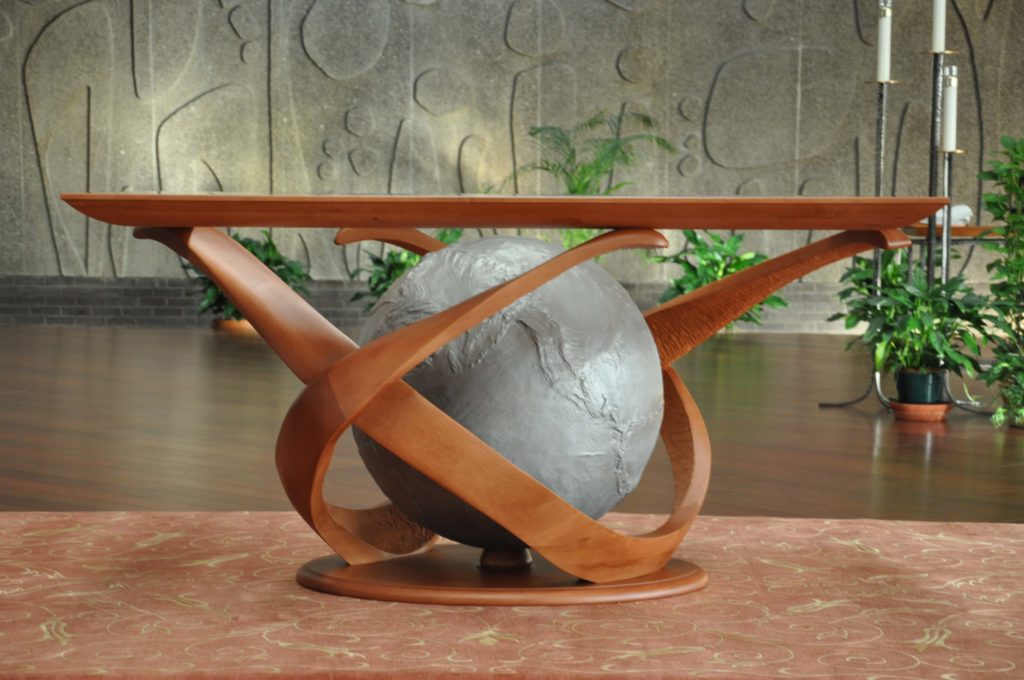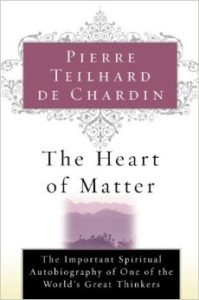“Eucharist” literally means “thanksgiving:” an offering up of praise and gratitude. Only in recent liturgical usage has the term come to be an accepted synonym for the Mass, or Holy Communion.
In 1923, on an geological expedition deep in the Ordos Desert of Mongolia, the newly minted priest Pierre Teilhard de Chardin pondered his obligation to offer a daily celebration of the mass – but how to do so in the middle of the desert, with neither bread nor wine (let alone the sacred vessels of the altar) available to him? His solution: the whole earth would become his altar, with the human toil and sufferings of the day to be offered up as his bread and wine.

The result of this profound reflection is Teilhard’s “The Mass on the World.” The original seed of this work  actually dates from Teilhard’s stretcher bearer days behind the French lines in World War I, but the work became a lifelong project – and a practice as much as a text. The most complete version (composed at Ordos) is a brilliant, five-part prose poem which you will find in its entirety in The Heart of Matter, Teilhard’s brilliant final autobiographical work. A slightly abridged version of the introductory (“The Offering”) section is included in Ursula King’s anthology: Pierre Teilhard de Chardin: Writings Selected with an Introduction by Ursula King (Orbis, 2008).
actually dates from Teilhard’s stretcher bearer days behind the French lines in World War I, but the work became a lifelong project – and a practice as much as a text. The most complete version (composed at Ordos) is a brilliant, five-part prose poem which you will find in its entirety in The Heart of Matter, Teilhard’s brilliant final autobiographical work. A slightly abridged version of the introductory (“The Offering”) section is included in Ursula King’s anthology: Pierre Teilhard de Chardin: Writings Selected with an Introduction by Ursula King (Orbis, 2008).
In our own times it seems that we have now arrived in strangely parallel circumstances. It’s not that bread and wine are literally unavailable, but the blessing and sharing of bread and wine – one of the few spiritual practices specifically mandated by Jesus – has become so problematic in today’s embattled institutional church that it often feels more like a minefield than a “communion,” let alone a holy one. There are questions of priestly power and control – who can celebrate and who can’t – and increasingly exclusive and rigid rubrics around who can receive and who can’t. On top of that, there is the growing cultural discomfort with the primary symbols themselves – wine is, after all, alcohol, and bread is gluten; and a rising demand for politically correct, chemically appropriate substitutes leaves the former stark simplicity of the communion table now looking like a cafeteria line, filled with a profusion of “self-service” alternatives.
At our most recent Wisdom School on Holy Isle in Scotland, we were dealing with yet an additional layer of complication: the whole island, run by Tibetan Buddhists whose intention is to maintain a uniform, very high planetary vibration, is explicitly “intoxicant free,” communion wine included. Everyone who visits or attends program on the island specifically agrees to this covenant.
So what’s to be done under the circumstances? The obvious solution is simply to use nonalcoholic wine (and gluten free bread) and dispose of the problem for once and for all. But if you’re like me, suspecting that Jesus’ use of transformed substances (wine and bread have both been through an alchemical process that transforms their nature) is both intentional and central to the meaning of the ritual, you don’t mess around with the designated primary symbols quite that lightly.
The alternative: a “negative space” eucharist based on The Mass on the World. (“Negative space,” incidentally, is a term from the art world: it means empty or open space deliberately built into a painting which is not “negative” at all from a compositional standpoint, but essential to the shape, meaning, and overall feel of the whole.)
I have offered this Teilhard mass three times now – at Wisdom Schools at La Casa de Maria in Santa Barbara, Valle Crucis in North Carolina, and Holy Isle in Scotland – and each time the impact has been powerful and utterly clean. It can be done without priests, without bread and wine, and across denominational and even interreligious lines: the only qualification for participation is to be “a member of the human race.” Drawing on the finest of Teilhard’s mystical/evolutionary vision, it touches the heart of the earth and the heart of humanity in a way that is not only fully eucharistic, but under some circumstances (such as on Holy Isle) even more universal and compelling than its official liturgical counterpart.
At any rate, I pass this on to you for further exploration and experimentation in your own Wisdom circles. At the very least, it’s another simple step forward into bringing Teilhard’s work into more active liturgical use.
Requirements:
Group gathered in a circle.
“Mass on the World” text from King (p. 80-81)
Two readers (reader 1, “priest,” reads paragraphs 1-3,6-7; reader 2, “deacon,” reads paragraphs 4-5, 8). Ideally, the two readers are sitting opposite from each other.
 In my own version of this ceremony, I have found it highly effective to read the text over the music “Essence,” by Peter Kater (available easily online). This single, free-flowing piece of white music somehow dialogues poignantly with the Teilhard text and draws the whole event into an integrated liturgical experience, not just a recitation (note: the piece is longer than the Mass itself; just use as much of it as you need and fade to silence when the recitation is finished; it accommodates easily).
In my own version of this ceremony, I have found it highly effective to read the text over the music “Essence,” by Peter Kater (available easily online). This single, free-flowing piece of white music somehow dialogues poignantly with the Teilhard text and draws the whole event into an integrated liturgical experience, not just a recitation (note: the piece is longer than the Mass itself; just use as much of it as you need and fade to silence when the recitation is finished; it accommodates easily).
At the end of paragraph 6 (“Once upon a time…the world borne ever onward in the stream of universal becoming…”), reader stands, and invites all in circle to o likewise.
At invocation in paragraph 7 (”Receive, O Lord, this all-embracing host which your whole creation, moved by your magnetism, offers to you at this dawn of a new day”) all raise their hands above their head, making their own oblation. Position is held for two minutes or so in silence, then as deacon reads the final paragraph. At the last words of this paragraph “Lord, make us one,” all in the circle are invited to join, separately and/or in unison.
Then priest/reader sits and all sit. Music fades, meditation follows for as long as is desired.
Give it a try and share your feedback. My blessings to you!
Cynthia

Cynthia shares a beautiful and powerful “negative space” eucharist based on Teilhard de Chardin’s The Mass on the World.
As a graduate of Georgetown University, I read Teilhard de Chardin as a student. I have always loved him, quoted him and generally viewed him as intellectually beyond my humble capacities.
Now, when I return to him, I am touched more deeply by his life story. His struggles, his losses, his work and his great ability to continue his soul’s evolution and to share that with others. I am in awe of the great simplicity that nurtured such complex perceptions of the world and cosmos – his devotion to the sacred heart of Jesus.
His soul – his marriage of self and spirit – as perceived through his life attracts me and calls forward in me an authentic, ancient and deep desire to belong.
I love that in his rooms when he died was his Litany to the sacred heart of Jesus that in part bespeaks his desire to unite with the heart of Jesus and the heart of Evolution. I know that desire – and I love knowing that this longing of the apostolic heart does not depend entirely on my intellectual prowess nor the challenges therein.
So, in complete acknowledgment of the great intellecutal invitations of Teilhard de Chardin and his brilliant work, I cling like a child to the idea that his soul’s simple longing and desire for the sacred heart of Jesus unites us. And in that, I hope i too will find the seeds of my own soul’s evolution – and a marriage of my self and my spirit.